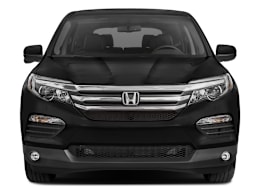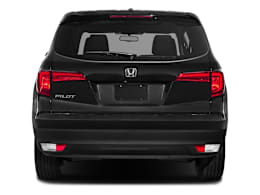At one time, driving a Honda Pilot meant that driving dynamics, family friendliness, and powertrain refinement were more important to you than the macho, trucklike SUV look. The Pilot was a natural next step for Civic and Accord owners with growing families. But something went awry in the late-2000s. Honda changed tack, making the Pilot more trucky and cheap-feeling.
Other manufacturers stole buyers by making a better Honda than Honda. With the 2016 redesign, Honda takes a swing at a softer, more carlike Pilot.
Built properly, an SUV performs the family-hauling duties of a minivan.
In that respect, the redesigned Pilot does a commendable minivan impression with its flexible seating for eight; a roomy, versatile, and feature-filled interior; and easy access to all three seating rows. But while it addresses many of the previous generation's flaws, the new Pilot is still lost in the fog.
When it comes to handling, this SUV has no connection with the nimble Hondas of the past. On open roads, the Pilot maneuvers like an apartment building on wheels. Its cumbersome cornering makes the Pilot feel reluctant to turn, and the vague steering chips away at your confidence. Nobody expects sports car handling from an SUV, but the Pilot is inferior to Honda's hulking Odyssey minivan -- whether meandering down the road or darting around obstacles. Plus, the Pilot's mediocre braking on wet roads trails most competitors.
The flip side to the Pilot's ungainly handling is a comfortable ride. This SUV's suspension smooths out bumps with composure. Some road imperfections will rock the Pilot from side to side, but overall a trip in the Pilot is uneventful. Honda loaded up on the sound-deadening materials, too, resulting in a quiet cabin.
The 3.5-liter V6 is a gem, smoothly and promptly delivering power throughout its rev range. Drivers are never left feeling in a dead zone of acceleration, with the standard six-speed automatic smoothly swapping gears. Our all-wheel-drive Pilot averaged 20 mpg overall in tests -- on par with other vehicles in the segment. Front-drive Pilots are likely to do 1 or 2 mpg better.
But shoppers should stick with the six-speed. The upmarket Touring and Elite trim levels are saddled with a nine-speed gearbox that's neither smooth nor responsive, and it uses an infuriating and unintuitive push-button shifter. At least the shifter has comprehensive safeguards against rollaway, should you accidentally forget to put the car in Park.
Interior materials and details are certainly improved, with hard, cheap plastics exiled to the recycling bin. All sizes of drivers found plenty of room, with good access to the pedals, adjustable steering wheel, and dashboard controls. Windows are big and roof pillars are thin, giving a commanding all-around view from the helm.
Though the front seats are well-padded and supportive, the lumbar adjusts only for pressure, not height. And some drivers felt that the front of the seat cushion didn't lower enough.
The second row is roomy, and the seats can slide fore/aft to give space to third-row occupants. The rearmost seats are best left for kids. Gauges are easy to read, and the climate controls are super-clear. But like every contemporary Honda, drivers must suffer with a convoluted touch-screen infotainment system. Fonts and buttons are large, but finding menus, changing the volume or radio station, or adjusting settings is frustrating. Consider the steering-wheel controls your copilot to handle tasks.
Advanced crash-prevention tech is available across the lineup, but only the top-level Elite gets blind-spot detection. In its place on most trims is the LaneWatch camera, but glancing at the display screen takes your eyes off the road.
Honda faithful will recognize this Pilot as an Odyssey in weekend warrior packaging, but will still wonder where the brand's cherished attributes -- such as intuitive controls and agile handling -- have gone.


























